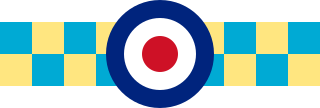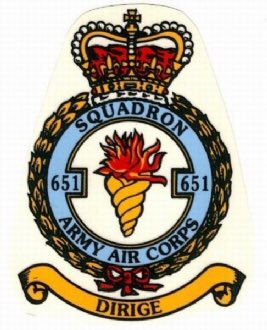No. 695 Squadron RAF was an anti-aircraft co-operation squadron of the Royal Air Force from 1943 to 1949.

667 Squadron AAC is a former squadron of the British Army's Army Air Corps (AAC).

No. 245 Squadron was a squadron of the Royal Air Force. It flew as an anti-submarine squadron during World War I and as a fighter squadron during World War II. After the war it was first a jet-fighter squadron and its last role was as a radar-calibration unit.
No. 666 Squadron AAC (V) is a former squadron of the British Army's Army Air Corps (AAC). It was previously No. 666 Squadron RAF, a unit of the Royal Air Force during the Second World War and afterwards became a Royal Auxiliary Air Force (RAuxAF) squadron between 1 May 1949 and 10 March 1957.
No. 684 Squadron RAF was a photo-reconnaissance squadron of the Royal Air Force from 1943 to 1946.
No. 682 Squadron RAF was a photo reconnaissance squadron of the Royal Air Force during the Second World War.
No. 598 Squadron RAF was an Anti-aircraft Co-operation squadron of the Royal Air Force during the Second World War.
No. 595 Squadron RAF was a squadron of the Royal Air Force from 1943 to 1949.
No. 587 Squadron RAF was an anti-aircraft co-operation squadron of the Royal Air Force from 1943 to 1946.
No. 511 Squadron was a Royal Air Force transport squadron, active during World War II, the Berlin Airlift and during the sixties and early seventies. It operated, during its three periods of existence, aircraft such as the Douglas Dakota, the Avro York, the Handley Page Hastings and the Bristol Britannia.
No. 663 Squadron was an air observation post (AOP) unit, manned with Polish Army personnel, which was officially formed in Italy on 14 August 1944. Numbers 651 to 663 Squadrons were air observation post units working closely with Army units in artillery spotting and liaison. A further three of these squadrons, 664–666, were manned with Canadian personnel. Their duties and squadron numbers were transferred to the Army with the formation of the Army Air Corps on 1 September 1957.

No. 651 Squadron Army Air Corps, is an aircraft squadron of the British Army, originally formed as No. 651 Squadron Royal Air Force in Italy and North Africa during the Second World War, and afterwards in Egypt. Numbers 651 to 663 Squadrons of the RAF were air observation post units which had both Army and RAF personnel. The pilots, drivers and signallers were in the Royal Artillery whilst the adjutants, technical staff and equipment officers came from the RAF. Air observation posts were used primarily for artillery spotting, but occasionally for liaison and other duties. Their duties and squadron numbers were transferred to the Army with the formation of the Army Air Corps on 1 September 1957.
No. 680 Squadron RAF was a photo-reconnaissance squadron of the Royal Air Force, active during the Second World War.
No. 292 Squadron RAF was an air-sea rescue (ASR) squadron of the Royal Air Force operating in the Bay of Bengal during the Second World War.
No. 287 Squadron was an anti-aircraft co-operation squadron of the Royal Air Force from 1941 to 1946.

No. 657 Squadron AAC was a squadron of the British Army's Army Air Corps (AAC), part of the Joint Special Forces Aviation Wing based at RAF Odiham. The squadron disbanded in May 2018 after the retirement of the Westland Lynx.
No. 654 Squadron AAC is a squadron of the British Army's Army Air Corps (AAC) that is currently the Headquarters Squadron for 4 Regt AAC. It was formerly No. 654 Squadron RAF, a unit of the Royal Air Force during the Second World War. Numbers 651 to 663 Squadrons of the RAF were air observation post units working closely with British Army units in artillery spotting and liaison. Their duties and squadron numbers were transferred to the Army with the formation of the Army Air Corps on 1 September 1957.
No. 652 Squadron AAC is a squadron of the British Army's Army Air Corps (AAC). It was previously No. 652 Squadron RAF, a unit of the Royal Air Force during the Second World War and afterwards in Germany.
No. 661 Squadron AAC is a squadron of the British Army's Army Air Corps (AAC). It was formerly No. 661 Squadron, a Royal Air Force air observation post squadron associated with the Canadian 1st Army and later part of the Royal Auxiliary Air Force. Numbers 651 to 663 Squadrons of the RAF were air observation post units working closely with British Army units in artillery spotting and liaison. A further three of these squadrons, 664–666, were manned with Canadian personnel. Their duties and squadron numbers were transferred to the Army with the formation of the Army Air Corps on 1 September 1957.
664 Squadron AAC is a squadron of the British Army's Army Air Corps. It was formerly No. 664 Squadron, a Royal Air Force air observation post squadron associated with the Canadian 1st Army during the Second World War and later part of the Royal Auxiliary Air Force. Numbers 651 to 663 Squadrons of the RAF were air observation post units working closely with British Army units in artillery spotting and liaison. A further three of these squadrons, 664–666, were manned with Canadian personnel. Their duties and squadron numbers were transferred to the Army with the formation of the Army Air Corps on 1 September 1957.






